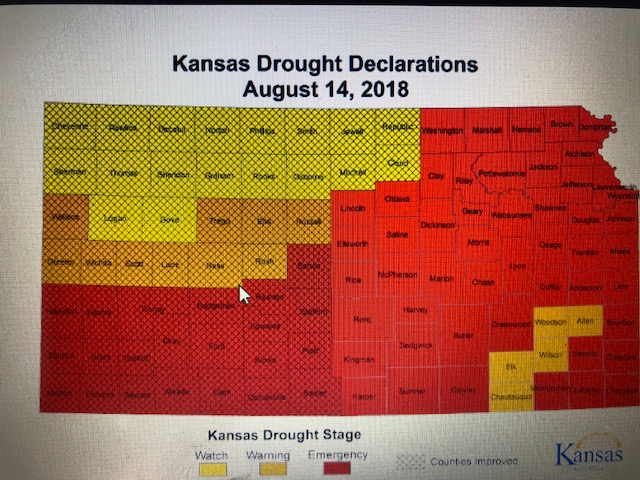SW Kansas still in emergency drought, despite improvement

Topeka – While there have been some recent rains, drought conditions for many areas of the state, especially eastern Kansas, continue to worsen.
Declining livestock water and feed supply continue to be reported. This has resulted in emergency status being added in eastern Kansas for any county with a U.S. Drought Monitor Severe Drought (D3) status, contiguous counties and reported issues. This now moves 10 counties into Emergency status from a Watch and 12 into Emergency from a Warning. Below are the counties listed in Bold indicating these changes.
Drought Watch counties (18): Cheyenne, Cloud, Decatur, Gove, Graham, Jewell, Logan, Mitchell, Norton, Osborne, Phillips, Rawlins, Republic, Rooks, Sheridan, Sherman, Smith, Thomas
Drought Warning counties (15): Allen, Chautauqua, Elk, Ellis, Greeley, Lane, Ness, Rush, Russell, Scott, Trego, Wallace, Wichita, Wilson, Woodson
Drought Emergency counties (72): Anderson, Atchison, Barber, Barton, Bourbon, Brown, Butler, Chase, Cherokee, Clark, Clay, Coffey, Comanche, Cowley, Crawford, Dickinson, Doniphan, Douglas, Edwards, Ellsworth, Finney, Ford, Franklin, Geary, Grant, Gray, Greenwood, Hamilton, Harper, Harvey, Haskell, Hodgeman, Jackson, Jefferson, Johnson, Kearny, Kingman, Kiowa, Labette, Leavenworth, Lincoln, Linn, Lyon, Marion, Marshall, McPherson, Meade, Miami, Montgomery, Morris, Morton, Nemaha, Neosho, Osage, Ottawa, Pawnee, Pottawatomie, Pratt, Reno, Rice, Riley, Saline, Sedgwick, Seward, Shawnee, Stafford, Stanton, Stevens, Sumner, Wabaunsee, Washington, Wyandotte
Counties in emergency stage are eligible for emergency use of water from certain state fishing lakes. They also become eligible for water in some Federal reservoirs.
Individuals and communities need to contact the Kansas Water Office (KWO) for a water supply request prior to any withdrawals from lakes. They will in turn be referred to the appropriate office to obtain the necessary permit to withdraw the water.
The Governor’s Drought Response Team will continue to watch the situation closely and work to minimize the effects the drought has on Kansans.









